
Posts Tagged "Communication"
Communicating in Times of Crisis Part 2- D Style
As we continue living in highly stressful times; I hope this message finds you well.
Now that so many of us are working remotely, we are finding communication much more challenging. Even with video conferencing tools, it is still difficult to observe and process all of the nonverbal cues that we used to depend on for communication with coworkers, customers, and vendors.
This is part 2 of Communicating in Times of Crisis- focusing on the D Style in the Team Strength DISC Tool.
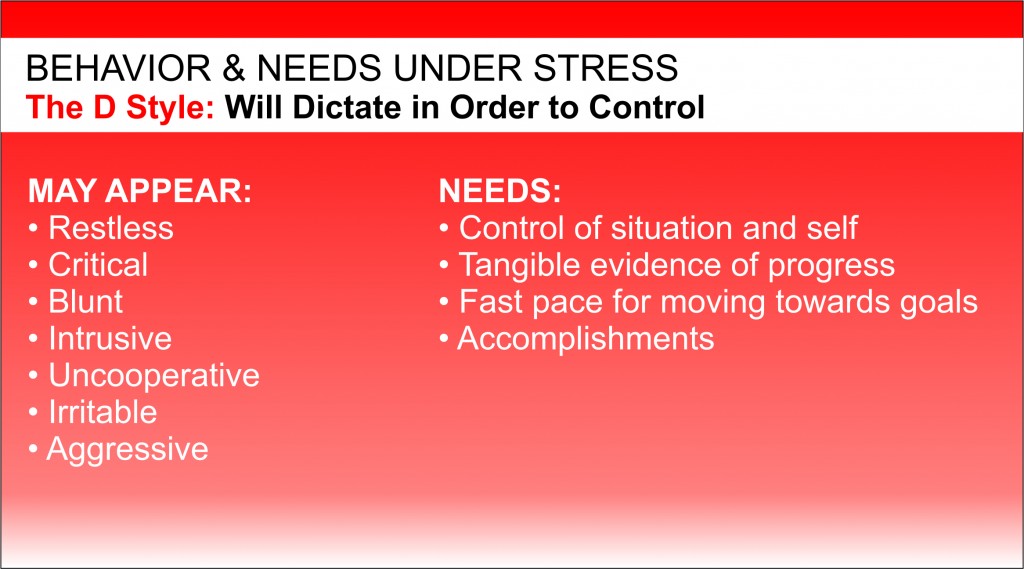
A decisive and ambitious person can become more aggressive and confrontational when things are out of control.

D Style
-
decisive
-
ambitious
-
results driven
-
likes being in charge
When we identify and control what is likely to stress us we can better react with thoughtfulness. (That is a good time to take a nice, deep breath.)
It is OK to understand and accept that we are under stress and not in a comfortable place. That will start to refill our emotional bank account when we need it most.
D Style
Emotional/Reactive: “If you can’t stand the heat, get out of the kitchen.”
Thoughtful: “I understand this is stressful. Let’s focus on what we CAN control.”
When we can get our own emotions controlled by understanding and managing the things that we can affect, then we will be in a better position to help others. By communicating more effectively and reducing our reactive behavior, we will be in a better position to be more accommodating to those around us, on phone calls or in a video chat.
We can then remember to treat others the way they want to be treated. Don’t try to “fix” people. We can remember that they have different needs and fears and we can adapt ourselves to their pace or priority as best we can. It’s a time that we all need to listen more and pay attention to what other behavioral expressions we are broadcasting and being more accepting of the reactions of others.
So, in these troubling times, we do have the ability to make deposits to our own emotional bank account. Even better, when we pay attention and care for others, we can also make emotional deposits to the accounts of those people who are important to us.
Stay safe, stay well.
Tim
Read the full article Communicating in Times of Crisis .
Send your questions about how to use your profile to identify and control what is likely to stress you sot that you can better react. Email
Call 772-210-4499 to set up a time to talk about tools and strategies that will lead to better results.
Communicating in Times of Crisis
Even when money is tight and the future is uncertain, remember to keep making deposits to your emotional bank account.
We are all living in highly stressful times; I hope this message finds you well.
Now that so many of us are working remotely, we are finding communication much more challenging. Even with video conferencing tools, it is still difficult to observe and process all of the nonverbal cues that we used to depend on for communication with coworkers, customers, and vendors.
Some of you that are working from home are fortunate to have your family with you. But by now you know that the additional job titles of teacher, cook, entertainer, etc., come with their stress-inducing challenges.
What to do?
First:
Breathe. Nice long relaxing breaths…
What we know about DISC in our own personality can help us, and those we care about, through the new abnormal.
When stress is present, people seek to reduce it, often by dumping it on the person “responsible” for the tension, which is unproductive. Each personality style has its own characteristic manner of “dumping” stress on another.
We all have stress-inducing situations that come and go in our lives. Lately, for most of us, the stress has been sticking around a lot longer. In crisis situations stress is amplified. Behavioral expressions can change, and behaviors may intensify. We need to be ever more vigilant in our interactions with those we care about and those who are dependent on us in our work and at home. This is not easy. Even people with highly developed emotional intelligence (EIQ) are struggling.
Emotional intelligence refers to the capacity to be aware of, control and express our emotions as well as understanding the emotions of others. Empathy is an important characteristic of high EIQ but can be very difficult to display when we are stressed and outside of our comfort zone. Identifying and addressing the characteristic fears of our personality type will help to avoid some of the rough spots. Those rough spots can drain your emotional bank account and reduce your EIQ.
The chart below shows how a reduced EIQ can negatively impact personality traits:
DISC + EMOTIONAL INTELLIGENCE
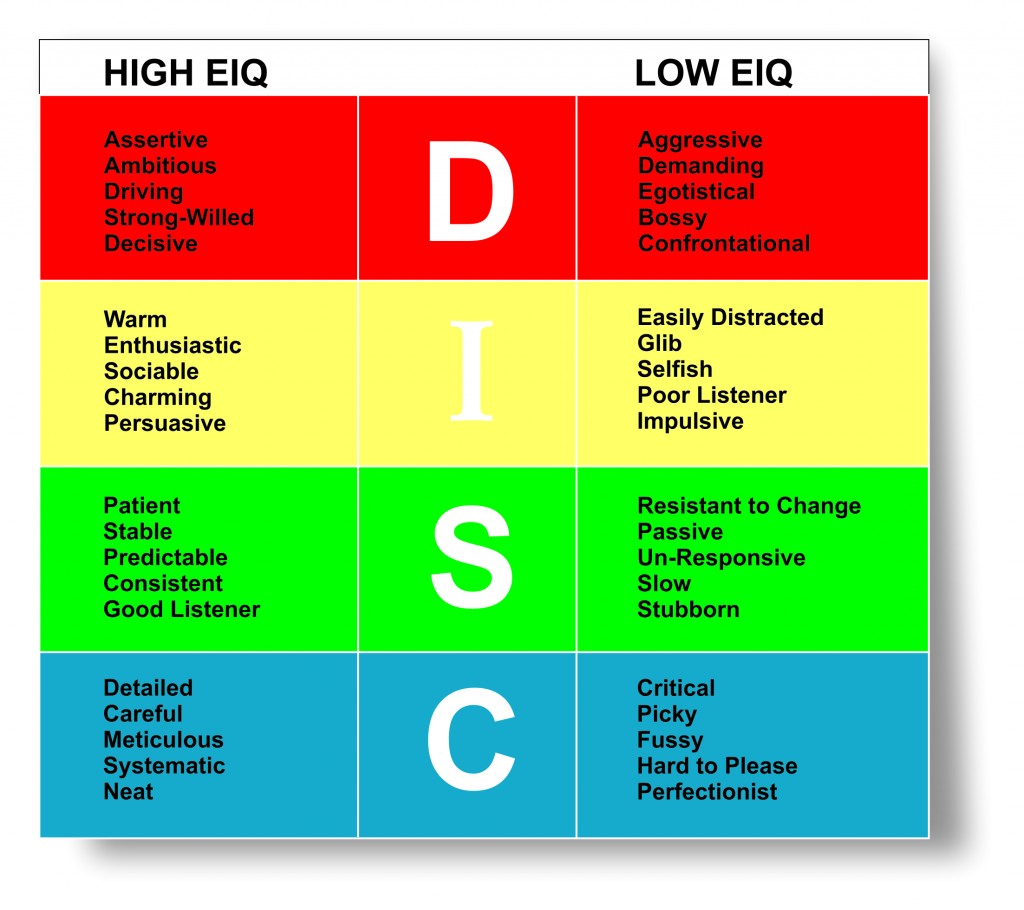
If you found yourself migrating toward the right side of the chart recently, you are not alone. Without being conscious of the change:
- A decisive and ambitious person can become more aggressive and confrontational when things are out of control.
- A normally sociable and charming individual can become glib and distracted without enough opportunity for social interactions.
- A patient, stable person can become stubborn or even un-responsive when there is no system or the normal pace of their life is disrupted.
- A careful, neat person can become very critical and fussy when new rules or restrictions are unclear or not universally adhered to.
The good news is that you can adapt back to more positive traits. Identify the cause of the stress, based on your personality type, and address it.
Take some time to review your Team Strength DISC profile. If you do not have a profile, then take a look at the graphic below with some broad descriptors of each of the DISC personality types. Find the broad descriptor that matches your personality best, keeping in mind that there may be two different areas that apply, and use that as your guide.
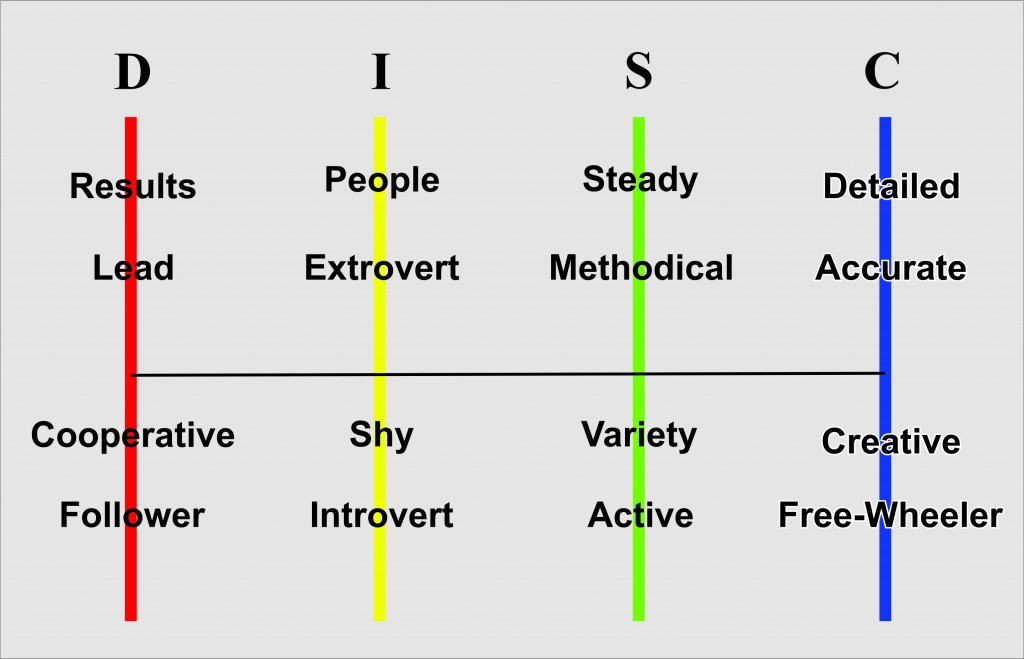
Your Team Strength DISC profile will describe in detail your personality type and highlight some of the drivers that you react to, what you need and also some of the fears that can affect you. The chart below summarizes three key areas in each of the four profile styles.
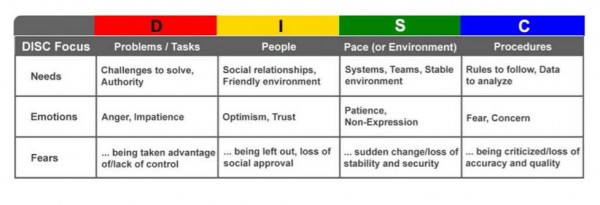
The following charts summarize the behaviors and needs of each style.

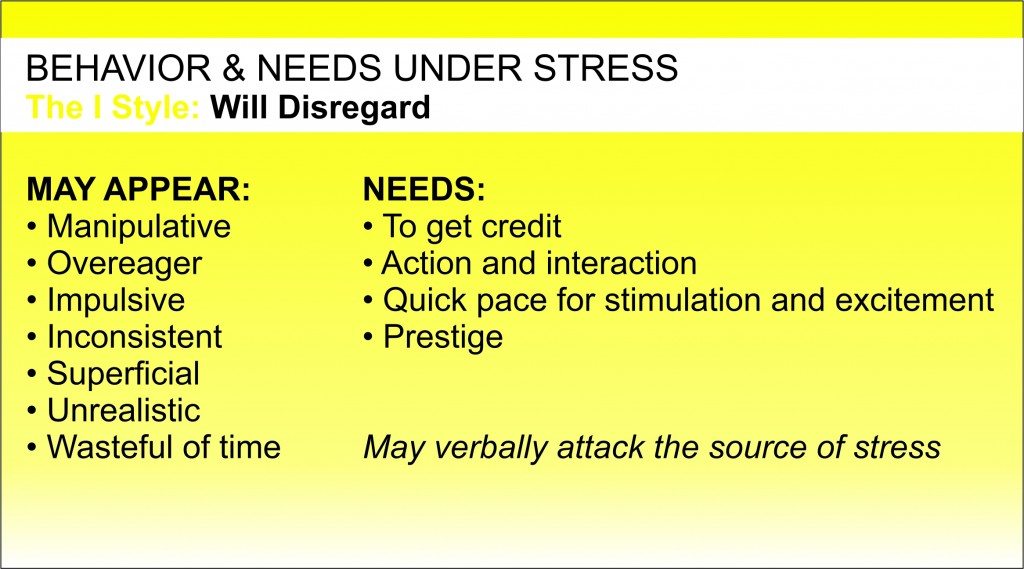
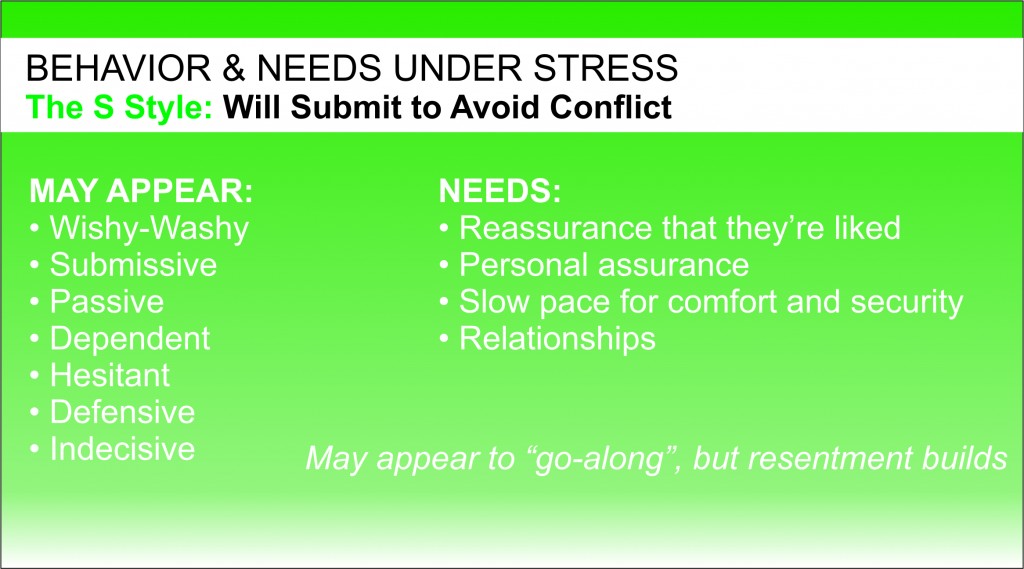
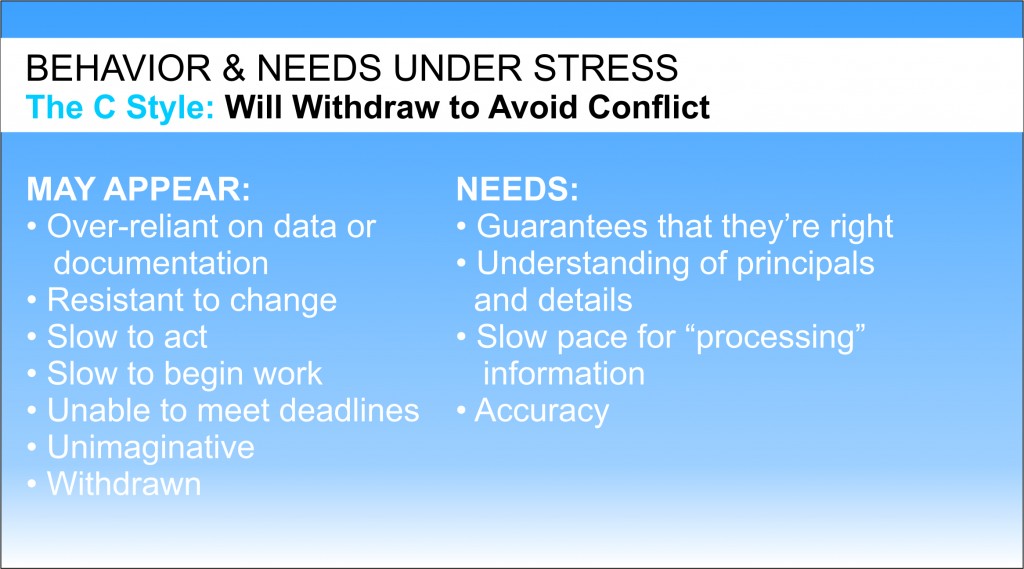
When we identify and control what is likely to stress us we can better react with thoughtfulness. (That is a good time to take a nice, deep breath.) It is OK to understand and accept that we are under stress and not in a comfortable place. That will start to refill our emotional bank account when we need it most. Here are comparisons for each style:
D Style
Emotional/Reactive: “If you can’t stand the heat, get out of the kitchen.”
Thoughtful: “I understand this is stressful. Let’s focus on what we CAN control.”
I Style
Emotional/Reactive: “Hey, let’s move on to something more positive!”
Thoughtful: “It’s difficult not seeing my friends. Can we find a time to get on a Zoom-social call?”
S Style
Emotional/Reactive: “Okay, if that’s the way you must have it, we’ll try it.”
Thoughtful: “I know things are uncertain right now. I just need to know that we are all in this together and we are going to get through it together.”
C Style
Emotional/Reactive: “I can’t help you any further. Do what you want.”
Thoughtful: “I know this is stressful. I just need to unplug for a day.”
When we can get our own emotions controlled by understanding and managing the things that we can affect, then we will be in a better position to help others. By communicating more effectively and reducing our reactive behavior, we will be in a better position to be more accommodating to those around us, on phone calls or in a video chat.
We can then remember to treat others the way they want to be treated. Don’t try to “fix” people. We can remember that they have different needs and fears and we can adapt ourselves to their pace or priority as best we can. It’s a time that we all need to listen more and pay attention to what other behavioral expressions we are broadcasting and being more accepting of the reactions of others.
So, in these troubling times, we do have the ability to make deposits to our own emotional bank account. Even better, when we pay attention and care for others, we can also make emotional deposits to the accounts of those people who are important to us.
Stay safe, stay well.
Tim
Send your questions about how to use your profile to identify and control what is likely to stress you sot that you can better react. Email
Call 772-210-4499 to set up a time to talk about tools and strategies that will lead to better results.
Please share this with a friend/colleague
More Tools:
The first step to building stronger communication is awareness. By identifying how we are similar and different, we can make cognitive choices when interacting to create stronger, more engaged relationships.
Deeper Look at Team Strength DISC Styles
Fierce Conversations – Book Review
Fierce Conversations
By: Susan Scott
Readitfor.me Book Review Summary
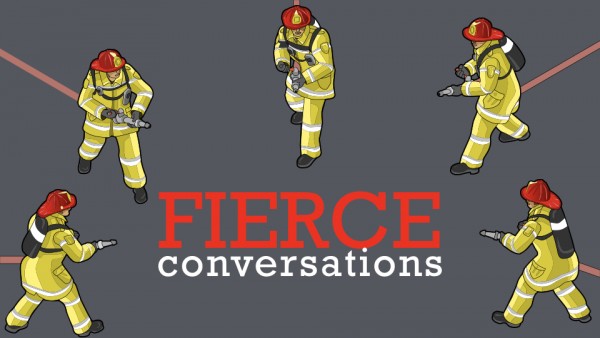
Far too often in business and life things are left unsaid.
We tell ourselves that we do it to preserve the peace in our relationships. But in reality, we are afraid of what might happen when we have those fierce conversations.
The predictable end result of those undiscussibless is the deterioration of the most relationships in our lives.
In Fierce Conversations, Susan Scott gives us 7 principles and 3 tools that we can use to get back into action, and finally have some real talk in the most important areas of our lives.
What Is a “Fierce” Conversation?
Before we get into the principles and tools, let’s define what a fierce conversation actually is.
Scott tells us that a fierce conversation is one in which we come out from behind ourselves into the conversation and make it real. It’s about moral courage, making real requests, and taking action.
There are 4 purposes to having one – to (1) interrogate reality, (2) provoke learning, (3) tackle tough challenges, and (4) enrich relationships.
With that definition and goals in mind, let’s get started.
Principle #1: Master the Courage to Interrogate Reality
There’s no way around it – having fierce conversations takes courage.
But here’s the reality – most people want to hear the truth, even if they don’t like what they hear. We respond deeply to people who level with us.
Know that when you bring up an issue that everybody else has been thinking about but sweeping under the rug, most people will be relieved that somebody is finally dealing with it.
Question to consider: what reality at home or work most needs interrogating?
Principle 2: Come Out from Behind Yourself into the Conversation and Make It Real
As Scott points out, you cannot be the person you want to be, or have the life you want, unless your actions represent an authentic expression of who you really are.
“Being authentic” isn’t a personality trait, it’s a choice. And until you choose to show yourself to the people in your life, you will never have the conversations you want or need in order to get there.
Here’s a question to ask yourself to determine whether or not you are being authentic in your relationships:
Are you sharing your dark days with the people who are closest to you? We all have them.
Question to consider: Where and with who am I failing to show up authentically?
Principle 3: Be Here, Prepared to Be Nowhere Else
There is a basic human need for people to be known.
Joseph Pine articulates this perfectly in his book The Experience Economy:
The experience of being understood, versus interpreted, is so compelling, you can charge admission.
Knowing this, our goal in any conversation needs to be to help the other person feel understood and known.
Even better, you should set time aside specifically for that goal to be met. Not as an add-on to your performance or project review, but with the sole purpose of talking the other person about whatever they deem the most important.
You’ll do that by using a tool called Mineral Rights, which we’ll cover in the tools section of the summary.
Question to consider: Who would benefit from my undivided attention?
Principle 4: Tackle Your Toughest Challenge Today
One of the greatest gifts that fierce conversations will give you is the ability to tackle your toughest challenges. No longer will you punt them down the road to deal with later, when you “have more time.”
There’s a saying that a problem named is a problem solved.
So before you’ll be able to get any use out of the tools we’ll cover in the tools section, you need to have the ability to identify the issues that need to be resolved with them.
If you need to confront someone’s behavior, do not begin by asking that person how things are going or by complimenting him or her.
As Scott says, don’t surround your message with pillows. Come straight at the issue and get right to the point.
We’ll cover exactly how to do this in the tools section.
Question to consider: What conversation am I dodging?
Principle 5: Obey Your Instincts
Scott suggests that the most valuable things any of us can do is to find a way to say the things that can’t be said.
These are the thoughts that go running through our head all day while we are interacting with people.
For instance, your spouse tells you they are thinking one thing, but everything in your being tells you that they are thinking something else.
An easy way to bring this up is to say something like “Would you like to hear something I’m feeling right now?” Then, if they agree, share your thoughts.
It’s an ingenious way to get a real issue on the table without feeling awkward doing it.
Question to consider: What messages have been beckoning me?
Principle 6: Take Responsibility for Your Emotional Wake
As a leader, there are no trivial comments.
There are most certainly things you’ve said in the past that have had a devastating impact on someone who was looking for your approval without you even knowing it.
Sometimes even innocent questions like “how’s that project going” can send your team members scurrying off, reprioritizing work schedules, and starting fires without you knowing it.
The principle here is to take 100% responsibility for the impact your words have on other people, and consider your words thoughtfully before you speak.
Question to consider: To whom do I need to apologize? Who deserves my praise?
Principle 7: Let Silence Do the Heavy Lifting
Scott jokes that CEOs are the most likely people to die with their mouth open.
Leaders are often taught to communicate until their people are sick of hearing the message. And then, communicate more.
But as Scott points out, the best leaders talk with people, not at them. Communication is not just about talking, it’s about listening too.
The best way to get another person to start talking is be silent. Most people are very uncomfortable with silence, and so will speak in order to break it.
Question to consider: What beneficial results might occur if I said less, listened more, and provided silence in which to think about what has (and has not) been said?
The Tools
Now that we’ve covered the principles, it’s time to move on to the tools you can use to put them into action.
Tool #1: Mineral Rights
One of the greatest gifts we can give to the people in our lives – at home and at work – is the purity of our attention.
Scott calls this tool Mineral Rights, which is a metaphor for drilling deep below the surface.
When you first bring this up, you and the person you want to meet with might feel awkward. To help ease the tension, here’s a script you can use to set up the meeting.
Rewrite it in your own words if that makes you feel more comfortable.
“When we meet tomorrow, I want to explore with you whatever you feel most deserves our attention, so I will begin our conversation by asking, “What is the most important thing you and I should be talking about?” I will rely on you to tell me. If the thought of bringing up an issue makes you anxious, that’s a signal you need to bring it up. I am not going to preempt your agenda with my own. If I need to talk with you about something else, I’ll tag it onto the end or plan another conversation with you.”
To get greater clarity on the things that are on the mind of the people who are most important to you (you can do this with yourself, too), ask your partner to take the following steps.
Step 1: Have them identify their most pressing issue.
Step 2: Ask them to clarify the issue. What’s going on? How long has it been an issue?
Step 3: Ask them to determine the current impact. How is it impacting them? What results are being produced (or not) because of it? How is it impacting others? What emotions are they feeling about the issue?
Step 4: Ask them to determine the future implications. If nothing changes, what might happen? What’s at stake here for them? For others? When they consider those possibilities, what emotions come up?
Step 5: Have them examine their personal contribution to this issue.
Step 6: Have them describe the ideal outcome. What difference will having the issue resolved make? What results will they enjoy? What are their emotions when they imagine the ideal outcome?
Step 7: Have them commit to action. What is the most potent step they could take to move this issue toward resolution? What’s getting in their way from doing it? When will they take the first step?
Because having a conversation this deep is new for most people, there are some common mistakes that might show up. Try to avoid them.
Doing most of the talking. Don’t do that.
Taking the problem away from someone. Some people are very skilled at handing back problems. Don’t let that happen.
Not inquiring about feelings. If you don’t check in with their emotions, nothing much will change. People make decisions to change emotionally, not rationally.
Delivering unclear messages, unclear coaching, and unclear instructions. Your goal should be to deliver no coaching or messages because you are trying to get them to solve the problem for themselves. But if you absolutely must, do it clearly and succinctly.
Canceling the meeting. Don’t do it.
Allowing interruptions. Turn off everything that might distract you from the conversation. Close your door, put away your phone, and shut down your computer. Whatever you need to do.
Running out of time. Every Mineral Rights conversation concludes with clarity about the next most important step. If that next step needs to be another conversation, schedule it.
Assuming your one-to-ones are effective.
Tool #2: Preparing an Issue For Discussion
Sometimes there are issues that you’ll want to resolve as a group, or where you need the input of the group to resolve it.
Preparing for these types of meetings in the following way allows you to accurately and clearly state the issue, and makes good use of everybody’s time.
Even better, put this into a document that you can distribute before the meeting so people can come prepared.
Step 1: State the issue.
Get to the heart of the problem in no more than one or two sentences. Is it a concern, challenge, opportunity or recurring problem that is becoming more troublesome?
Step 2: Communicate the significance
You job here is to determine what’s at stake. Is it a gain/loss in revenue? Gaining/losing a new customer? Gaining/losing an employee?
Step 3: Communicate your ideal outcome
What specific results do you want?
Step 4: Give relevant background information
Using bullet points, give the information that you feel will be helpful for the group considering the resolution of the issue. How, when and why the issue began is a good place to start.
Step 5: Tell them what you have done up to this point…
Tell them what you’ve done so far, and what options you are considering.
Step 6: Tell them what help you are looking for
Tell them the result you are looking for. For instance, are you looking for alternative solutions because you don’t like the ones you’ve come up with? Or are you hoping they’ll give you feedback on what you plan on doing?
Tool #3: The Confrontation Model
Finally, we end with the confrontation tool, which will allow you to confront tough issues with courage, compassion, and skill.
The best part about this tool is that you’ll find that you are finally having these conversations because you have a strategy for them.
Part I : The Opening Statement
The first sixty seconds are crucial to a confrontational conversation. That’s why it’s critical that you script it beforehand, and practice saying it out loud.
Here’s what you should include:
Name the issue. If there is more than one, ask yourself what’s at the core of all of them.
Select a specific example that illustrates the behavior or situation you want to change. Be specific and succinct. If you don’t do this, the conversation will have no teeth.
Describe your emotions about this issue. Telling the other person how you are feeling creates intimacy and is disarming.
Clarify what is at stake. It’s critical that the other person understands why this issue is important. Scott suggests that we use the words “at stake”, and that we speak calmly and quietly – even if we are angry.
Identify your contribution to this problem. You may realize, for instance, that your contribution to the problem is not communicating clear expectations from the outset of the relationship or project.
Indicate your wish to resolve the issue. You are not firing or breaking up with anybody – it’s important that they hear you say that.
Invite your partner to respond. You want to be clear that you want to understand the issue from their point of view. This is your invitation for them to join the conversation.
Part II: Interaction:
This is a conversation, so the next step is to get a clear understanding of their side of the story.
- Inquire into your partner’s views. When it’s appropriate, paraphrase their words so you are clear on what they are trying to communicate. Make sure your partner knows that you fully understand and acknowledge his or her position and interests.
Part III: Resolution
Finally, the goal of these conversations is to come to a resolution.
Where are we now? Ask whether there is anything that has been left unsaid, and cover what is needed for resolution.
Make a new agreement and determine how you will hold each other responsible for keeping it.
Conclusion
Bad communication leads to misunderstanding, confusion, lost time, talent and profits.
Tim Kinane
Call 772-210-4499 or email to set up a time to talk about tools and strategies that will lead to better results.
Please share this with a friend/colleague
Why Community Service
Congratulation to Dr. Jack Mitchell who has received two new awards from his involvement in the community. One of the awards is Volunteer of the Year Award from an organization that focuses on providing safe space and assistance primarily to women and children involved in domestic violence. The second new award is from the local Chamber of Commerce. Dr. Jack received the prestigious President’s Award for “dedication, hard-work and commitment”.
There are great reasons and benefits to volunteering:
- Good for your health
- Learn new skills
- Gain professional experience
- Make a difference/improve lives
- Get to know your community
- Challenge yourself
- Connect with others
Strengthen your Team by Connecting your WHY with volunteering in your community.
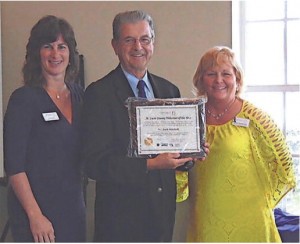
Tracy Levy, SafeSpace director of Development; Dr. Jack Mitchell, St. Lucie Volunteer of the Year; Janet Farnan-Dyer, SafeSpace Resource & Volunteer Coordinator
We are proud to present our St. Lucie County Volunteer of the Year, Dr. Jack Mitchell. Dr. Jack’s contribution as a Board Member and Advocate in the community creates future financial sustainability to help us save and change lives of victims and their families. Thank you Dr. Jack for your endless dedication to SafeSpace and our mission. We appreciate all that you do!!
Why Community Service
A conversation with Dr. Jack Mitchell
Dr. Jack, congratulation on your two new community service awards.
I feel such gratitude, and simply want to give back. I have a strong awareness of how fortunate and how blessed I am in life, an awareness of “why” I am here on earth. Volunteerism simply flows as a result of this gratefulness.
I like the quote by the famous lecturer and writer, Jim Rohm:
“It is the set of the sails, not the direction of the wind that determines which way we will go.”
I draw from this: Know your personal “why” ; set your sail accordingly because the winds of life will challenge all of us; be grateful for your blessings; and be generous with your time, talent and treasure.
The Why is about how you feel – and we are inspired by that which moves us and connects us to other people. Dr. Jack Mitchell shares his why:
As a volunteer, I am impressed with the dedication and love of so many staff employees. They give of their time and talent so very generously to their organizations and the people they serve.
My Why is to help people grow personally and professionally.
I have been blessed with exceptional education, corporate and entrepreneurial experiences. I am passionate to use all these to help people. It feels great to give back.
Communication starts by understanding yourself and then listening to others. How have you used your understanding of Team Strength DISC to help you to be a better volunteer?
The Team Strength DISC profiles and chart, are tools that I can use in every aspect of my life: work, volunteering and personal interactions. I have been involved with this process and system for more than 30 years. Using these tools has helped me to develop the sensitivity to assess and communicate effectively. This was not always the case, years ago, I would make assumptions, mis-read people and miss opportunities.
I still do day, but hopefully nowhere near what I did years ago. What a powerful tool for all of us today. The more you practice, the better you get. Whether in business, in family matters, or in general communication, the Team Strength DISC Profiles are marvelous help to better communication.
Communication is life’s most important skill- better communication make for a better life.
Set your organizations sails by improving the quality of your teams’s communication. Get started now on your Team Strength- call 772-210-4499 or email for more information or to set up and an account.
How Do Others Hear You?
Answer: It’s not what you say – it’s what they hear.
Effective communication ensures that others hear what we mean.
What if you could have an enhanced view of your communication interaction with others? Often times, what we say and what others hear are two very different things. Managers and business leaders often persist in communication and organizational practices believing everyone recognizes their “obvious” intentions, overlooking costly misinterpretations that stem from different behavioral styles. Those challenges lead to workplace inefficiencies that that were difficult to resolve— until now!
Team Strength
Our Team Strength Interactive Tool significantly improves a manager’s effectiveness in critical, real time communication with employees.
We Leverage the insights of the DISC profile with a web based tool to conveniently identify and address the specific obstacles to teamwork and better results.
- Strategize difficult conversations.
- Coach employees to effectively communicate with each other.
- Maximize your team dynamics.
Contact us for a complimentary demonstration.
Plan now for Spring and Summer Workshops and Training Programs
Each of our workshops can be customized to the current needs and challenges of your organization. They are engaging, enlightening and fun and will lead to improved cooperation and interaction.
Workshop Portfolio
Want to improve quality of your company’s communication? Get started now on your Team Strength- call 772-210-4499 or email for more information or to set up and an account.

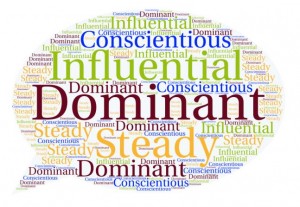
 Tim is a Consultant to Business, Government and Not-for-Profits Organizations specializing in innovative and challenging ways for organizations to survive, to thrive and to build their teams.
Tim is a Consultant to Business, Government and Not-for-Profits Organizations specializing in innovative and challenging ways for organizations to survive, to thrive and to build their teams.